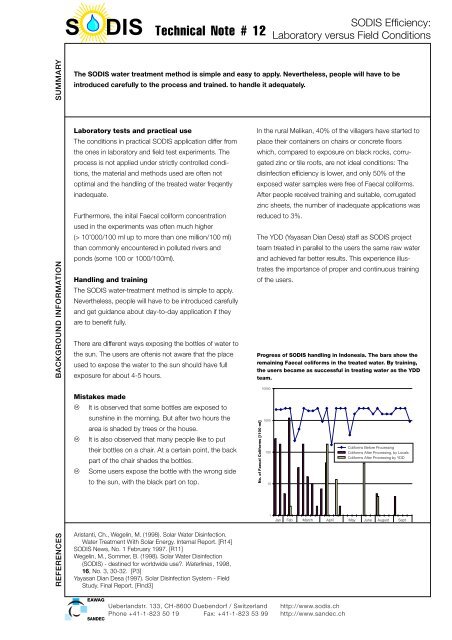Technical Notes
Technical Notes
Technical Notes
- No tags were found...
You also want an ePaper? Increase the reach of your titles
YUMPU automatically turns print PDFs into web optimized ePapers that Google loves.
S DIS <strong>Technical</strong> Note # 12SODIS Efficiency:Laboratory versus Field ConditionsBACKGROUND INFORMATION SUMMARYThe SODIS water treatment method is simple and easy to apply. Nevertheless, people will have to beintroduced carefully to the process and trained. to handle it adequately.Laboratory tests and practical useThe conditions in practical SODIS application differ fromthe ones in laboratory and field test experiments. Theprocess is not applied under strictly controlled conditions,the material and methods used are often notoptimal and the handling of the treated water freqentlyinadequate.Furthermore, the inital Faecal coliform concentrationused in the experiments was often much higher(> 10’000/100 ml up to more than one million/100 ml)than commonly encountered in polluted rivers andponds (some 100 or 1000/100ml).Handling and trainingThe SODIS water-treatment method is simple to apply.Nevertheless, people will have to be introduced carefullyand get guidance about day-to-day application if theyare to benefit fully.There are different ways exposing the bottles of water tothe sun. The users are oftenis not aware that the placeused to expose the water to the sun should have fullexposure for about 4-5 hours.In the rural Melikan, 40% of the villagers have started toplace their containers on chairs or concrete floorswhich, compared to exposure on black rocks, corrugatedzinc or tile roofs, are not ideal conditions: Thedisinfection efficiency is lower, and only 50% of theexposed water samples were free of Faecal coliforms.After people received training and suitable, corrugatedzinc sheets, the number of inadequate applications wasreduced to 3%.The YDD (Yayasan Dian Desa) staff as SODIS projectteam treated in parallel to the users the same raw waterand achieved far better results. This experience illustratesthe importance of proper and continuous trainingof the users.Progress of SODIS handling in Indonesia. The bars show theremaining Faecal coliforms in the treated water. By training,the users became as successful in treating water as the YDDteam.Mistakes made☹ It is observed that some bottles are exposed tosunshine in the morning. But after two hours thearea is shaded by trees or the house.☹ It is also observed that many people like to puttheir bottles on a chair. At a certain point, the backpart of the chair shades the bottles.☹ Some users expose the bottle with the wrong sideto the sun, with the black part on top.No. of Faecal Coliforms [/100 ml]10000100010010Coliforms Before ProcessingColiforms After Processing, by LocalsColiforms After Processing by YDD1Jan Feb March April May June August SeptREFERENCESAristanti, Ch., Wegelin, M. (1998). Solar Water Disinfection.Water Treatment With Solar Energy. Internal Report. [R14]SODIS News, No. 1 February 1997. [R11]Wegelin, M., Sommer, B. (1998). Solar Water Disinfection(SODIS) - destined for worldwide use?. Waterlines, 1998,16, No. 3, 30-32. [P3]Yayasan Dian Desa (1997). Solar Disinfection System - FieldStudy. Final Report. [FInd3]Ueberlandstr. 133, CH-8600 Duebendorf / Switzerland http://www.sodis.chPhone +41-1-823 50 19 Fax: +41-1-823 53 99 http://www.sandec.ch
















